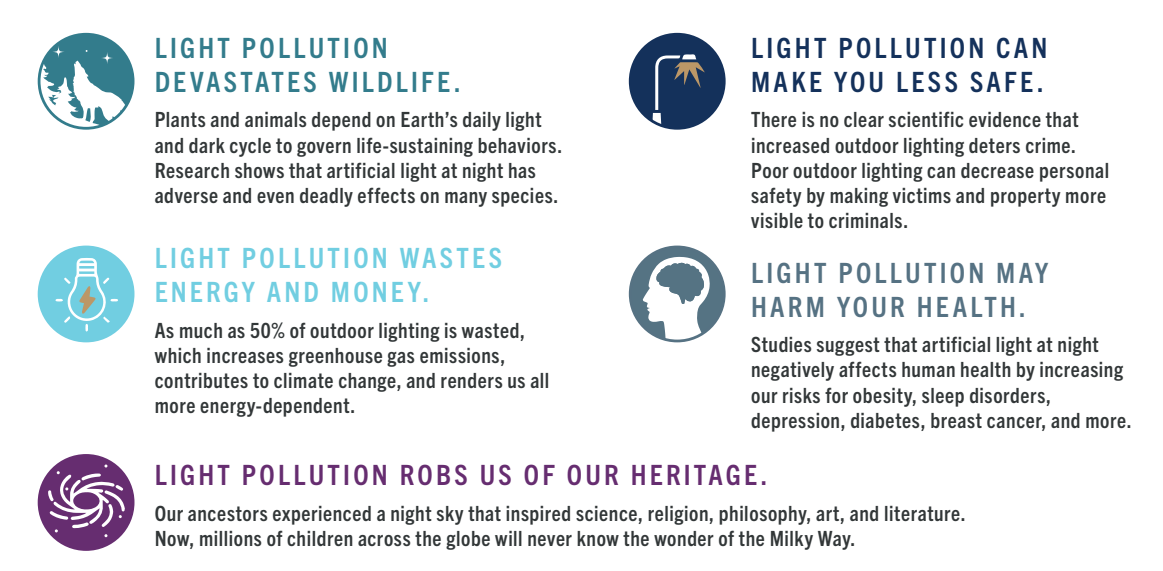Marine Light Pollution | 15 Sep 2023
For Prelims: Artificial lighting, corals and plankton
For Mains: Artificial Light at Night (ALAN) - significance and associated issues, Impact of artificial lightning on organisms, Light Pollution
Why in News?
The impact of artificial lighting on land-based life (humans, fireflies, and birds) has been known for quite some time.
- However, a recent US-based study has argued to consider light pollution’s influence on coastal marine organisms as well which affects everything from whales to fish, corals, and plankton.
What is Artificial Lighting in the Marine Environment?
- About:
- Artificial lighting refers to the light that is produced from artificial sources such as candles, fire, electricity, etc.
- Ecologists and biologists have long recognized that artificial light at night can have adverse effects on the health of humans and terrestrial wildlife.
- Recent research is showing that marine life is also sensitive to artificial light, including extremely low levels and certain wavelengths, particularly blue and green light.
- Artificial lighting refers to the light that is produced from artificial sources such as candles, fire, electricity, etc.
- Marine Light Pollution: When this artificial light is used excessively or poorly, it becomes light pollution and disrupts the natural patterns of wildlife, contributing to the increase in carbon dioxide (CO2) in the atmosphere.
- The scientists found that 1.9 million km2 of the ocean experience biologically significant amounts of artificial light pollution to a depth of 1 metre.
- This represents about 3% of the world’s Exclusive Economic Zones (EEZs).
- Significant areas of the ocean are seeing light exposures to depths of 10 metres, 20 metres, or more.
- In areas with very clear water, the light at night can reach depths of more than 40 metres.
- The scientists found that 1.9 million km2 of the ocean experience biologically significant amounts of artificial light pollution to a depth of 1 metre.
- Sources:
- Coastal development (e.g., buildings, streetlights, billboards, ports, piers, docks and, light house).
- Vessels (e.g., fishing and merchant marine vessels), harbours and offshore infrastructure such as oil rigs.
- Some of the common types of artificial lights in the marine environment are LED, fluorescent, metal halide, and plasma lamps.
- White LEDs produce broad spectrum light that is sensed by a wide range of organisms and have a peak at short wavelengths (blue and green light) to which many marine organisms are particularly sensitive.
Note:
- The Earth is getting artificially brighter, at a rate of 2.2% per year. As a result of these brighter nights, the impacts of artificial light at night (ALAN) have become an increasing focus in terrestrial ecology.
- As per studies, non-natural light increased the brightness of Skyglow, by 9.2-10% every year between 2011 and 2022
- Research has shown that ALAN is a major form of anthropogenic pollution that can affect a wide range of biotic processes, including physiology, behaviour, animal movements, species interactions, community structure and reproduction.
How does Artificial Lightning Affect the Marine Ecosystem?
- Disruption of Normal Cycles: As per the study, it already took marine organisms an evolution of over millions of years to adapt to natural light and now the threat of ever-increasing anthropogenic light pollution has been posing several threats to them.
- Artificial light can easily wash out the glow of moonlight and starlight consequently disrupting their hormonal cycles, inter-species behaviour, and reproduction cycles.
- Illustration: For instance, to lay their eggs, female sea turtles try to find a quiet, dark spot and avoid light. However, due to artificial lightning, they may end up not coming ashore at all.
- Moreover, their hatchlings head toward inland lights instead of moonlight on the water and then die of dehydration or starvation.
- LEDs Worsening the Impact: The ever-growing usage of LED lighting is also altering the very nature of artificial light.
- Suggestion:
- Encouraging land-based Lights Out efforts (local, state, and regional campaigns to darken skies) to help migrating birds that are drawn to light at night. It will also benefit marine systems near coastal cities.
- Increasing the usage of red light in coastal areas as much as possible and putting up barriers to shield the coastline from artificial light.
- Red light, having the longest wavelength in the visible spectrum, doesn’t penetrate as far into the water.

